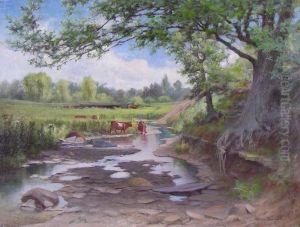Amos W. Sangster Paintings
Amos W. Sangster was a notable American artist born in 1833 in Lawrenceville, New Jersey. He was primarily known for his detailed and picturesque etchings that captured the essence of the Niagara Falls and its surrounding landscapes. Sangster's work is a testament to his profound appreciation of natural beauty and his exceptional skill in etching, a form of printmaking that was highly popular in the 19th century.
Sangster's life was marked by a dedication to the arts from an early age. He moved to Buffalo, New York, where he would spend a significant portion of his life and where his fascination with the Niagara region began. This area, with its dramatic waterfalls, rugged landscapes, and changing seasons, provided endless inspiration for Sangster. He embarked on a monumental project to create a series of etchings that depicted the Niagara Falls and the Niagara River, showcasing not just the grandeur of the falls themselves but also the quiet beauty of the surrounding areas.
Throughout the 1880s, Sangster worked on this series, which culminated in the publication of a portfolio titled "Niagara River and Falls from Lake Erie to Lake Ontario." This collection was highly acclaimed for its artistic merit and technical precision. Sangster's ability to capture the dynamic and ephemeral qualities of water, light, and atmosphere was particularly notable. His work was not only a celebration of natural beauty but also an early example of environmental awareness, highlighting the need to preserve such magnificent landscapes for future generations.
In addition to his etchings, Sangster was an educator, teaching art and sharing his passion for etching with others. His contributions to the art community were recognized during his lifetime, and he was a respected figure among his contemporaries. After his death in 1904, Sangster's work continued to be appreciated by art collectors and historians, particularly those with an interest in American landscape art and the history of the Niagara region. His legacy is that of an artist who deeply loved and meticulously documented one of North America's most iconic natural wonders, leaving behind a body of work that continues to captivate and inspire.
